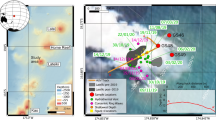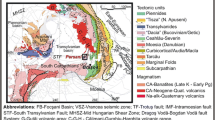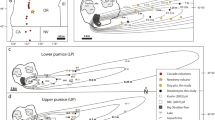Abstract
Field, geochronologic, and geochemical evidence from proximal fine-grained tephras, and from limited exposures of Holocene lava flows and a small pyroclastic flow document ten–12 eruptions of Mount Rainier over the last 2,600 years, contrasting with previously published evidence for only 11–12 eruptions of the volcano for all of the Holocene. Except for the pumiceous subplinian C event of 2,200 cal year BP, the late-Holocene eruptions were weakly explosive, involving lava effusions and at least two block-and-ash pyroclastic flows. Eruptions were clustered from ∼2,600 to ∼2,200 cal year BP, an interval referred to as the Summerland eruptive period that includes the youngest lava effusion from the volcano. Thin, fine-grained tephras are the only known primary volcanic products from eruptions near 1,500 and 1,000 cal year BP, but these and earlier eruptions were penecontemporaneous with far-traveled lahars, probably created from newly erupted materials melting snow and glacial ice. The most recent magmatic eruption of Mount Rainier, documented geochemically, was the 1,000 cal year BP event. Products from a proposed eruption of Mount Rainier between AD 1820 and 1854 (X tephra of Mullineaux (US Geol Surv Bull 1326:1–83, 1974)) are redeposited C tephra, probably transported onto young moraines by snow avalanches, and do not record a nineteenth century eruption. We found no conclusive evidence for an eruption associated with the clay-rich Electron Mudflow of ∼500 cal year BP, and though rare, non-eruptive collapse of unstable edifice flanks remains as a potential hazard from Mount Rainier.











Similar content being viewed by others
References
Beget JE (1982) Postglacial volcanic deposits at Glacier Peak, Washington, and potential hazards from future eruptions. US Geol Surv Open-File Rep 82–830:1–77
Bronk Ramsey C (1995) Radiocarbon calibration and analysis of stratigraphy: the OxCal program. Radiocarbon 37:425–430
Bronk Ramsey C (2001) Development of the radiocarbon program OxCal. Radiocarbon 43:355–363
Crandell DR (1971) Postglacial lahars from Mount Rainier Volcano, Washington. US Geol Surv Prof Pap 677:1–75
Crandell DR, Waldron HH (1956) A Recent volcanic mudflow of exceptional dimensions from Mount Rainier Washington. Am J Sci 254:349–362
Crandell DR, Mullineaux DR, Rubin M, Spiker K, Kelley ML (1981) Radiocarbon dates from volcanic deposits at Mount St. Helens, Washington. US Geol Surv Open-File Rep 81–844:1–14
Crowley JK, Zimbelman DR (1997) Mapping hydrothermally altered rocks on Mount Rainier, Washington, with airborne visible/infrared imaging spectrometer (AVIRIS) data. Geology 25:559–562
Fiacco RJ, Palais JM, Germani MS, Zelinski GA, Mayewski PA (1993) Characteristics and possible source of a 1479 A.D. volcanic ash layer in a Greenland ice core. Quat Res 39:267–273
Finn CA, Sisson TW, Deszcz-Pan M (2001) Aerogeophysical measurements of collapse-prone hydrothermally altered zones at Mount Rainier volcano. Nature 409:600–603
Frank DG (1995) Surficial extent and conceptual model of hydrothermal system at Mount Rainier, Washington. J Volcanol Geotherm Res 65:51–80
Hagstrum JT, Champion DE (2002) A Holocene paleosecular variation record from 14C-dated volcanic rocks in western North America. J Geophys Res 107:2025, doi:10.1029/2001JB000524
Hoblitt RP, Walder JS, Driedger CL, Scott KM, Pringle PT, Vallance JW (1998) Volcano hazards from Mount Rainier, Washington, revised 1998. US Geol Surv Open-File Rep 98–428:1–11
Hopson CA, Waters AC, Bender VR, Rubin M (1962) The latest eruptions from Mount Rainier volcano. J Geol 70:635–647
John DA, Sisson TW, Breit GN, Rye RO, Vallance JW (2008) Characteristics, extent and origin of hydrothermal alteration at Mount Rainier Volcano, Cascades arc, USA: implications for debris-flow hazards and mineral deposits. J Volcanol Geotherm Res 175:289–314, doi:10.1016/j.jvolgeores.2008.04.004
Majors HM, McCollum RC (1981a) Mount Rainier the tephra eruption of 1894. Northwest Discovery 6:334–381
Majors HM, McCollum RC (1981b) First winter expedition to Mount Rainier 1894. Northwest Discovery 6:406–464
McKenna JM (1994) Geochemistry and petrology of Mount Rainier magmas: petrogenesis at an arc-related stratovolcano with multiple vents. MSc thesis, University of Washington, Seattle
Mullineaux DR (1974) Pumice and other pyroclastic deposits in Mount Rainier National Park, Washington. US Geol Surv Bull 1326:1–83
Mullineaux DR (1996) Pre-1980 tephra-fall deposits erupted from Mount St. Helens, Washington. US Geol Surv Prof Paper 1563:1–99
Scott KM (2004) Lahars, LIDAR, and forensic documentation of flow origins, behaviors, and pathways at Mount Rainier, Washington. In: Aguirre-Díaz GJ, Macías-Vázquez JL, Siebe C (eds) Neogene–Quaternary continental margin volcanism. Publicatión especial 2. Universidad Nacional Autónoma de México, Instituto de Geologia, Mexico, pp 111–117
Scott KM, Vallance JW, Pringle PT (1995) Sedimentology, behavior, and hazards of debris flows at Mount Rainier, Washington. US Geol Surv Prof Paper 1547:1–56
Sigafoos RS, Hendricks EL (1972) Recent activity of glaciers of Mount Rainier, Washington. US Geol Surv Prof Pap 387:1–24
Sisson TW, Grove TL (1993) Experimental investigations of the role of H2O in calc–alkaline differentiation and subduction zone magmatism. Contrib Mineral Petrol 113:143–166
Sisson TW, Vallance JW, Pringle PT (2001) Progress made in understanding Mount Rainier's hazards. EOS Trans Am Geophys Union 82:113–119
Stockstill KR, Vogel TA, Sisson TW (2002) Origin and emplacement of the andesite of Burroughs Mountain, a zoned, large-volume lava flow at Mount Rainier, Washington, USA. J Volcanol Geotherm Res 119:275–296
Swanson D (1993) Variation in the grain size distribution and the chemical composition of the Mount Rainier C-ash unit. BSc thesis, University of Puget Sound, Tacoma
Vallance JW, Scott KM (1997) The Osceola mudflow from Mount Rainier: sedimentology and hazards implications of a huge clay-rich lahar. Geol Soc Am Bull 109:143–163
Venezky D, Rutherford MJ (1997) Pre-eruption conditions and timing of dacite-and esite mixing in the 2.2 ka C-layer at Mount Rainier. J Geophys Res 102:20069–20086
Yamaguchi DK (1983) New tree-ring dates for recent eruptions of Mount St. Helens. Quat Res 20:246–250
Yoder HS Jr, Steward DB, Smith JR (1957) Ternary feldspars. Yearb Carnegie Inst Wash 55:206–214
Zehfuss PH, Atwater BF, Vallance JW, Brenniman H, Brown TA (2003) Holocene lahars and their by-products along the historical path of the White River between Mount Rainier and Seattle. In: Swanson TW (ed) Western Cordillera and adjacent areas: Geol Soc Am Field Guide 4. Geological Society of America, Boulder, CO, pp 209–223
Zimbelman DR (1996) Hydrothermal alteration and its influence on volcanic hazards—Mount Rainier, Washington, a case history. Ph.D. thesis, University of Colorado, Boulder
Acknowledgements
J Byman and C Harpell assisted JV in the field. D Champion provided advice on paleomagnetic results. R Oscarson expertly maintained the USGS Western Region electron microprobe facility. Whole-rock analyses were performed by J Budahn (INAA) and by the late D Seims (XRF). J Fierstein, M-A Longpré, P Pringle, and K Wallace provided constructive manuscript reviews, and J Stix edited the manuscript for the Bulletin. P Pringle supplied key samples for the Zehfuss et al. (2003) study. This study was supported by the U.S. Department of the Interior, Geological Survey, Volcano Hazards Program.
Author information
Authors and Affiliations
Corresponding author
Additional information
T. W. Sisson and J. W. Vallance contributed equally to this study.
Electronic supplementary material
Below is the link to the electronic supplementary material.
ESM Table 1
Electron-microprobe major-oxide analyses of glasses from late-Holocene Mount Rainier tephras (DOC 651 KB)
ESM Table 2
Electron-microprobe major-oxide analyses of glasses from CIgW-I and -II ashy sediments between MR-TC and MSW-W tephras at Summerland (DOC 161 KB)
ESM Table 3
Electron-microprobe major-oxide analyses of glasses from Kautz Creek ashy sand atop MSH-W tephra (DOC 111 KB)
ESM Table 4
Electron-microprobe major-oxide analyses of glasses from ashy sands overlying MSH-W tephra at Paradise, Mount Rainier (DOC 95.5 KB)
ESM Table 5
Electron-microprobe major-oxide analyses of glasses from juvenile-appearing grains in the White River confluence lahar (DOC 148 KB)
ESM Table 6
Whole-rock chemical compositions of glassy clasts from White River confluence lahar (DOC 57.0 KB)
ESM 1
(DOC 32.5 KB)
Rights and permissions
About this article
Cite this article
Sisson, T.W., Vallance, J.W. Frequent eruptions of Mount Rainier over the last ∼2,600 years. Bull Volcanol 71, 595–618 (2009). https://doi.org/10.1007/s00445-008-0245-7
Received:
Accepted:
Published:
Issue Date:
DOI: https://doi.org/10.1007/s00445-008-0245-7




